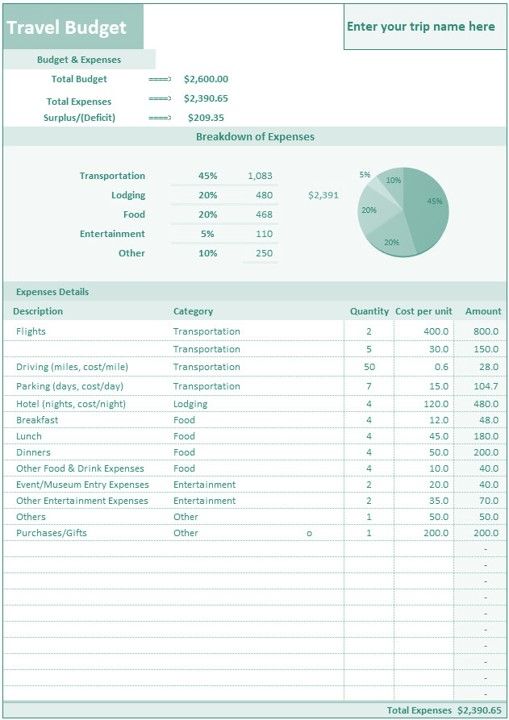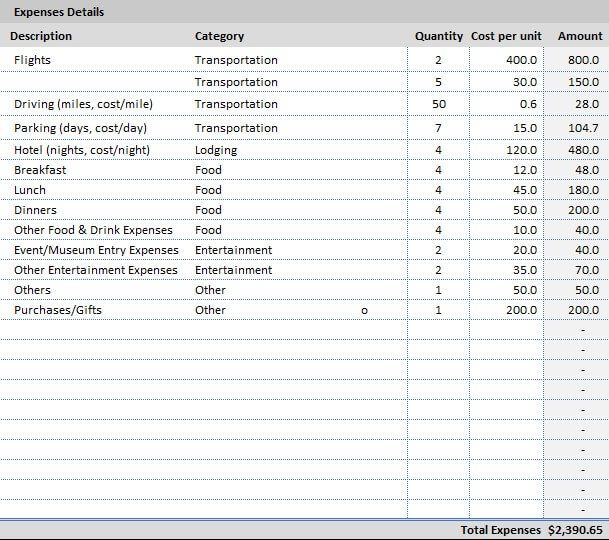Table Of Contents
What Is Travel Budget Template?
People may use travel budget templates to plan their travel budgets, put their budgets and all possible expenses on one sheet, and determine the shortfall or surplus. Moreover, it helps them to plan itineraries and cut or add to their itineraries according to budget.

Such templates not only facilitate proper financial planning for traveling but also introduce discipline and strategy while using funds for the purpose of preventing overindulgence in spending too much on food, shopping, entertainment, and other amusements while traveling. This makes the travel enjoyable without resource wastage.
Travel Budget Template Explained
The travel budget template is a document that is designed in a format that helps travelers plan their financial resources in such a way that they already have an idea regarding the various areas that will require spending while traveling, along with the amount of money allotted for each. This excel travel budget template very helpful because it creates a sense of responsibility regarding the utilization of resources so that travelers do not go overboard with their expenses.
All of us quite often plan for trips that may be within a state, country, or international. They may be official or personal, with family and friends. Thus, the cost to be incurred often makes us worried and creates a doubt in our minds as to whether we will be able to stay within our budget. This is because while going for a trip, be it official or personal, there is always a huge possibility of using money for purposes like shopping, food and dining, entertainment, etc. The excel travel budget template above gives a clear view of some possible areas of using money during trips. But many of them are such that the expenses made behind them can be kept to a minimum in order to manage the entire trip within a particular range of funds.
The above process should be done in order to enjoy the trip as well as not have a sense of regret regarding overspending after the trip is over. Very often it is seen that people are so eager to enjoy that they end up borrowing money for the purpose from their near and dear ones. Such habits should not be encouraged at all. This template is a great method to avoid such habits and utilize one’s resources in a planned and meaningful way.
Travel Budget Template In Excel
The given template is exhaustive, starting with the travel budget and incorporating all your expenses to arrive at a budgeted surplus or shortfall. It can be used as a business travel budget template or for personal travelling. It also displays a pie chart in excel, which provides a pictorial presentation of expenses. It contains the following heads:
#1 - Budget and Expenses
The head displays the total budget and expenses. The total budget is input, while total expenses and surplus/shortfall are calculated fields. Refer to the screenshot below for details:

#2 - Expenses Pie Chart
The pie chart is a pictorial presentation of expenses that is auto-populated based on the inputs in the next section. The expenses are grouped into broad categories. The pie chart is prepared to present those categories only. Refer to the screenshot below for details.

#3 - Expenses Details
The user of personal or business travel budget template can use this section to input expense details covering all expenses the user will expect to incur during the travel. The expenses are broken into the number of units per expense and the cost per unit. The amount column gives the total of each line item. Refer to the screenshot below for details.

How To Make?
As a user of printable travel budget template, you can start right away with the template to plan your travel. But first, start with your total budget.
#1 - Total Budget
The total budget is an amount you would have kept aside for the trip. It is an estimated number that you would have earmarked as your budget. Start with an amount that will not result in the stretching of your finances. If you have this figure in your mind in advance, you will do well in populating the next expenses section. This section may have to work on again and again if the budget and expected expenses are not in sync.
#2 - Expenses
Once you have earmarked your travel budget, you can move on to expenses. The expenses are grouped under five basic categories in the template: transportation, lodging, food, entertainment, and others.
All these categories have further sub-heads directly populated in the table. Following is how we unpack these categories.
#3 - Transportation
Transportation expenses in a printable travel budget template will include all your flight expenses, which might form a big chunk of your overall expenses. It’s important to consider how seasonal factors can affect travel costs. For example, if you're planning to go on a Tanzania Safari tour, knowing the ideal time to visit can help you better plan for expenses related to flights, local transportation, and safari activities. Transportation includes taxi/bus/metro/trains, driving, and parking. You need to calculate the total number of units, including to and from. The measure of units and the per-unit cost is in parentheses in the line item.
#4 - Lodging
Lodging will include the cost of living, mainly hotels. You can only input other expenses, like resorts, apartments, etc., in the hotel section. You can also add rows to incorporate more detail if you will be changing accommodations during the trip. You can then put the number of stays in each hotel and the daily cost to arrive at your total lodging expenses.
#5 - Food
Food is also necessary while traveling as travelers love to explore food when they visit different places within or outside their countries. Further, the food expense breaks down into three meals: breakfast, lunch, and dinner. Calculate the meals for all days and put a cumulative number in the quantity field. The cost per meal is self-explanatory.
#6 - Entertainment
Entertainment expenses include visiting amusement parks, participating in activities, watching shows, visiting museums, etc. There could be a long list of things you could do on a trip. If you want to list them separately, you can add rows and adequately categorize them in the category row for it to show up correctly in the pie chart.
#7 - Other
All other expenses, like shopping and purchases, are bunched into others. So make sure you categorize expenses correctly for them in the pie chart.
The necessary work that one needs to do before travel is to decide on which places he will be traveling to and the length of stay at each location. It can be an excellent exercise to list expenses of different places separately by adding rows to make a more precise assumption on the expenditures. Accounting for multiple locations to travel separately will be a good exercise because traveling costs, including food, lodging, and transportation, will differ for different places.
Example
Let us understand the concept of simple travel budget template with the help of a suitable example, as given below:
We assume that John is travelling to his hometown with his family, which includes his wife, two children and a pet dog. It is suppose to be a long stay, almost a month, and therefore it is obvious that they will enjoy going around, meeting friends and relatives, shopping and thus, spending money.
John has a very planned approach to everything. He always stays within limits when it comes to finance. Therefore, it is natural that he will use a method that will help and guide him regarding how much money to use in which areas. After calculating the total amount available to him, he breaks it up into amount that will meet the various expenses. The flight is the area that will require most amount of money, which he first keeps aside. The rest, he skillfully distributes among hotel expenses, vehicles to be hired for roaming around, visiting places, food and dining, etc. They also have some plans to attend two live shows related to music and education, which he thinks will be good for his kids. Overall, he uses a pre-designed template downloaded from a site, that has similar details and will allow him to fill up the amount, thus, saving time.
Thus, we see that this simple travel budget template are very useful because it gives a visual overview about the total fund available for spending and allow us to clearly see where the money will possibly go or any extra funds are needed, perhaps to pay for some unavoidable expenses. In this way we can also select better options for travelling like driving instead of flight, which is cheaper, and provided the time and distance permits, We can also go for cheaper hotels which will offer good facilities but not extract money for fancy but unnecessary facilities.
While planning travel, one must research the approximate costs of all the heads to estimate a reasonable estimate of expenses. Without research, the estimated cost and the actual costs may differ significantly, putting the user’s entire travel budget at risk.
The user must make sure to add the right category while adding rows for the pie chart to be correctly updated. In the case of shortfalls, one can increase the budget or rework the expenses to bring the travel expenses under budget.

